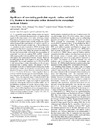Please use this identifier to cite or link to this item:
https://accedacris.ulpgc.es/handle/10553/53076
| Title: | Significance of non-sinking particulate organic carbon and dark CO2 fixation to heterotrophic carbon demand in the mesopelagic northeast Atlantic | Authors: | Baltar González, Federico Aristegui, Javier Sintes, Eva Gasol, Josep M. Reinthaler, Thomas Herndl, Gerhard J. |
UNESCO Clasification: | 251001 Oceanografía biológica | Keywords: | Dark CO2 fixation Heterotrophic carbon demand Dark ocean |
Issue Date: | 2010 | Journal: | Geophysical Research Letters | Abstract: | It is generally assumed that sinking particulate organic carbon (POC) constitutes the main source of organic carbon supply to the deep ocean's food webs. However, a major discrepancy between the rates of sinking POC supply (collected with sediment traps) and the prokaryotic organic carbon demand (the total amount of carbon required to sustain the heterotrophic metabolism of the prokaryotes; i.e., production plus respiration, PCD) of deep-water communities has been consistently reported for the dark realm of the global ocean. While the amount of sinking POC flux declines exponentially with depth, the concentration of suspended, buoyant non-sinking POC (nsPOC; obtained with oceanographic bottles) exhibits only small variations with depth in the (sub)tropical Northeast Atlantic. Based on available data for the North Atlantic we show here that the sinking POC flux would contribute only 4–12% of the PCD in the mesopelagic realm (depending on the primary production rate in surface waters). The amount of nsPOC potentially available to heterotrophic prokaryotes in the mesopelagic realm can be partly replenished by dark dissolved inorganic carbon fixation contributing between 12% to 72% to the PCD daily. Taken together, there is evidence that the mesopelagic microheterotrophic biota is more dependent on the nsPOC pool than on the sinking POC supply. Hence, the enigmatic major mismatch between the organic carbon demand of the deep-water heterotrophic microbiota and the POC supply rates might be substantially smaller by including the potentially available nsPOC and its autochthonous production in oceanic carbon cycling models. | URI: | https://accedacris.ulpgc.es/handle/10553/53076 | ISSN: | 0094-8276 | DOI: | 10.1029/2010GL043105 | Source: | Geophysical Research Letters [ISSN 0094-8276], v. 37 (9), L09602, (Mayo 2010) | Rights: | by-nc-nd |
| Appears in Collections: | Artículos |
SCOPUSTM
Citations
71
checked on Jun 8, 2025
WEB OF SCIENCETM
Citations
69
checked on Jun 8, 2025
Page view(s)
96
checked on Jan 25, 2025
Download(s)
81
checked on Jan 25, 2025
Google ScholarTM
Check
Altmetric
Share
Export metadata
Items in accedaCRIS are protected by copyright, with all rights reserved, unless otherwise indicated.
